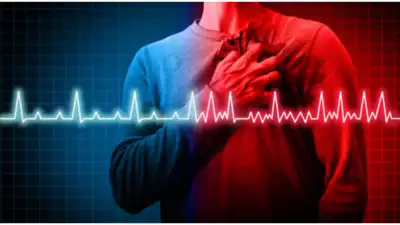Globally, heart diseases are now the primary cause of death and disability. The most concerning of them is sudden cardiac arrest, which can happen suddenly and happens within an hour of the onset of symptoms.
It appears that even healthy people can succumb to this type of heart-related death, sometimes known as “sudden cardiac death.”
Both healthy individuals and those with established, stable cardiac problems are at danger.
WHAT IS SUDDEN CARDIAC ARREST?
Sudden cardiac arrest is the sudden loss of heart activity due to an irregular heart rhythm. In this, breathing stops. This event may occur when the heart arteries are clogged with cholesterol or other deposits, reducing blood flow to the heart.
Sometimes, a heart attack can lead to sudden cardiac arrest.
RISING CASES AMONG YOUNG PEOPLE
Sudden cardiac arrest is not uncommon among young individuals and is on the rise.
According to Dr Rajiv Agarwal, Principal Director, Cardiology, Max Smart Super Speciality Hospital, Saket, New Delhi, around 80% of cases occur in people with coronary artery disease.
“If angiography (medical imaging like X-ray to check blood vessels) is done, these people have narrowing or blocks. Yet most do not have a heart attack which, in medical terms, denotes a sudden block of a coronary artery with damage to heart muscle,” Dr Rajiv Agarwal told to media.
Most instances are not linked to heart attacks but are primarily due to abnormal heart rhythms, such as ventricular tachycardia and ventricular fibrillation.
STRATEGIES FOR PREVENTION
Since there is a rise in sudden cardiac arrests in young people, Dr Agarwal suggested understanding the risks and mitigating them.
“Addressing risk factors for coronary artery disease is crucial. This includes managing hypertension (the number one cause), quitting smoking, controlling diabetes, maintaining a healthy weight, staying physically active, and adopting a nutritious diet,” the expert said.
He cautioned, “Prevention efforts should start early in life, as heart disease tends to progress from higher risk in young adults to early death in middle age.”
Importance of early screening
The second prevention strategy involves early and regular screening for heart disease and risk factors. Screening every three years after the age of 40 is recommended, or earlier for those with a family history or high-risk features.
Drug therapy, especially for conditions like high blood pressure, cholesterol, and diabetes, may be necessary, Dr Agarwal suggested.
High-risk individuals may even require implanted defibrillator devices, which can be life-saving.
In cases of cardiac arrest in young individuals, especially teenagers and those in their 20s, heart muscle diseases, or cardiomyopathies, are often the cause.
Therefore, it is advised that students and young adults in their 20s undergo routine screening, which includes clinical examination, electrocardiogram, and echocardiography.
It is also possible to provide cascade screening, a methodical procedure for identifying members of a family who are susceptible to a hereditary disease.
Role of exercise
Despite concerns about exercise-related risks, regular, well-paced exercise is protective.
“Endurance and high-intensity athletes may benefit from regular screening exams. Since cardiac arrest is often fatal, prevention is paramount,” said Dr Agarwal.
CPR training
Experts suggest that since cardiac arrests are fatal, the best strategy is prevention. Timely CPR can help in survival.
“CPR training for the public, the availability of automated external defibrillators in public places, and increased awareness programs can significantly reduce the incidence of fatal cardiac arrests,” said Dr Agarwal.







 Finance
Finance







